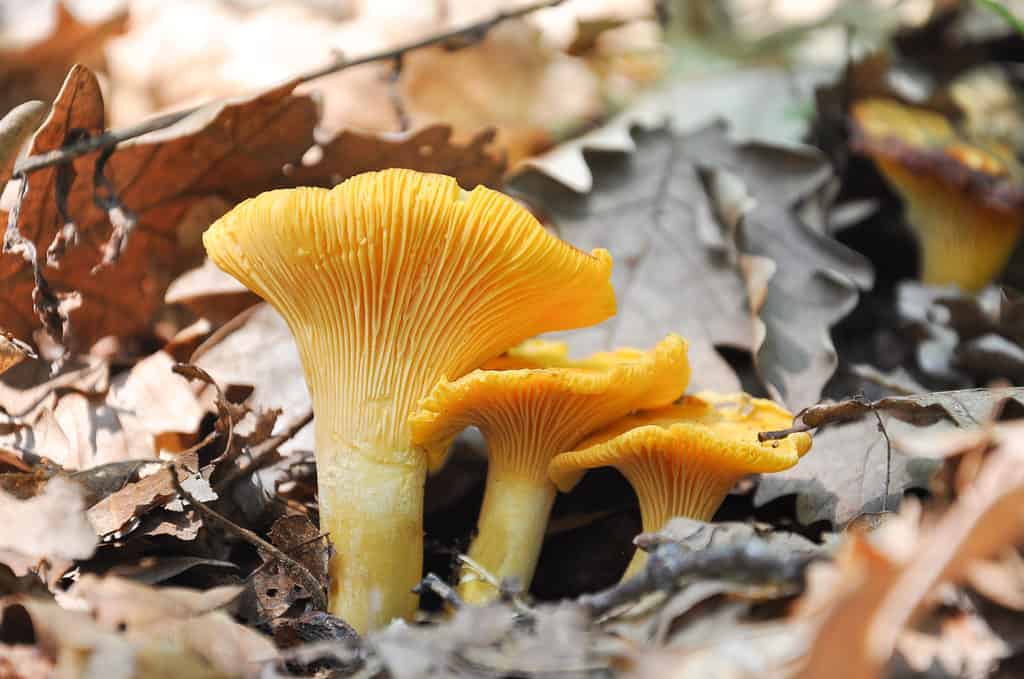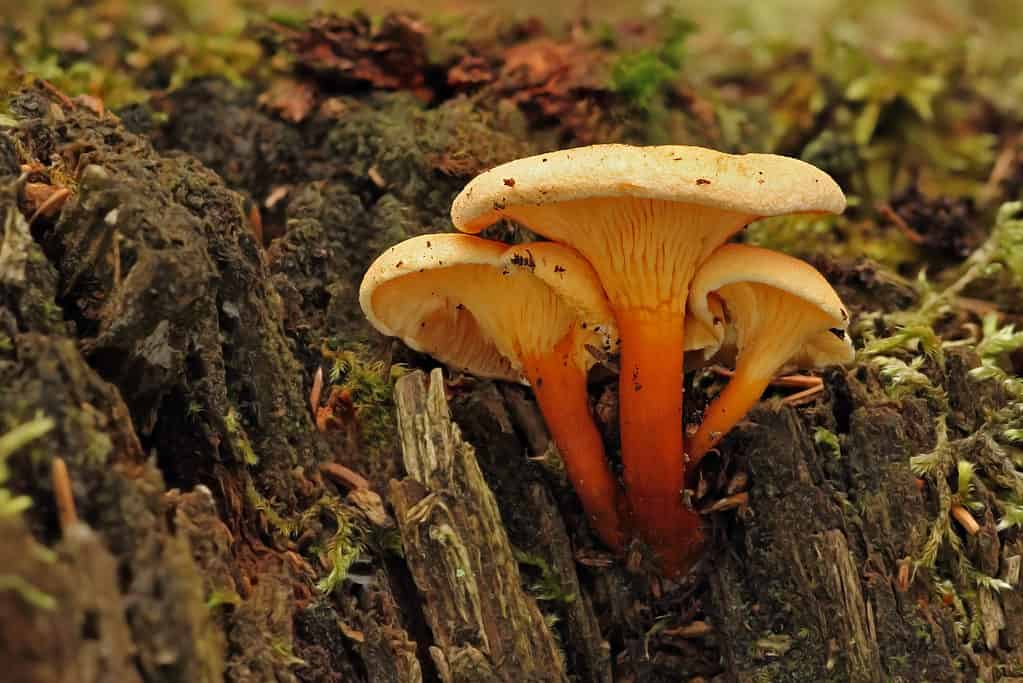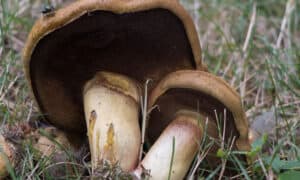Because chanterelles may be confused with their inedible lookalike, the false chanterelles, it is important to know the differences between the two! This article compares and contrasts chanterelles with false chanterelles. By the end, you should be able to identify each one and know which is safe to eat – and which should be avoided. Let’s learn about these together now.

Here is a close-up of Cantharellus cibarius, or Chanterelle mushrooms, growing in a cluster.
©Ivan Marjanovic/Shutterstock.com
Chanterelles vs. False Chanterelles
| Characteristic | Chanterelles | False Chanterelles |
|---|---|---|
| Scientific Name | Cantharellus (genus) | Hygrophoropsis aurantiaca (species) |
| Genus | There are multiple species called “chanterelles,” many of which are in the Cantharellus genus. Some mushrooms called “chanterelles” are in the genera of Craterellus, Gomphus, and Polyozellus. | Hygrophoropsis |
| Family | Cantharellaceae | Hygrophoropsidaceae |
| Division | Basidiomycota | Basidiomycota |
| Kingdom | Fungi | Fungi |
| Common Name | Chanterelle, golden chanterelle | False chanterelle |
| Origin | Asia, Australia, Europe, North America, South America and Africa | Asia, Australia, Europe, North America, South America |
| Description of Fungus | Species in the Cantharellus genus are called “chanterelles.” The species Cantharellus cibarius one of the most common in Europe. Chanterelles range in color, with some species being orange, yellow, and white. When cut open, chanterelles are white on the inside. The term “chanterelle” is typically used to refer to the species Cantharellus cibarius, in Europe, or some of the similar species in North America. However, there are many other species in this genus, which take a variety of shapes and colors. Cantharellus cibarius is medium to large and reaches 1 to 4 inches across and 2 to 4 inches tall, though some specimens have been as large as 6 inches across. The cap is conical and wavy. | Hygrophoropsis aurantiaca is known as “false chanterelle” because of its similar appearance to Cantharellus cibarius. The false chanterelle is also found in hardwood or conifer forest environments, where it gains nutrients from decomposing wood. False chanterelles are deep orange in color, with no yellow, and have true gills that are forked and can be separated. They are not pure white on the inside, but have an orange hue. They also have slightly hollowed out stems. The cap is rounded, and the false chanterelle loses any waviness as it matures. |
| Scent | Fruity, sometimes described as apricot- or peach-like | Earthy, mushroomy |
Descriptions of Chanterelles vs. False Chanterelles
Description of Chanterelles
“Chanterelles” are various fungi species in the Cantharellus genus of the Cantharellaceae family. Of the many species in the genus, “golden chanterelles” found in Europe and North America are among the best-known. Cantharellus cibarius grows in Europe, while North America has several common species of chanterelles. These include Cantharellus appalachiensis, Cantharellus elensis, Cantharellus formosus, Cantharellus lateritius, and Cantharellus phasmatis. In North America, you can find more than 40 different species of chanterelles. They grow natively in forest environments with moist soil and moss or grass. Because they have a symbiotic relationship with pine or oak trees, you will often find them in soil at the base of trees. In these wooded areas, you can find chanterelles growing individually or in groups.
Chanterelles are one of the most commonly-foraged types of edible mushrooms. Although researchers previously believed that the majority of chanterelles in North America were varieties of the Cantharellus cibarius species. However, it is now accepted among mycologists that Cantharellus cibarius is not native to North America. Instead, the chanterelle species found growing in the forests of North America represent a number of distinct species. Some of the most common have similar appearances to Cantharellus cibarius, also called a “golden chanterelle” or “girolle,” and are yellow or orange in color and conical or funnel-shaped with wavy edges. These chanterelles often taste somewhat fruity and emit a fruity fragrance similar to that of an apricot or peach.
Description of the False Chanterelle
The species Hygrophoropsis aurantiaca is known as the “false chanterelle” because of it looks somewhat similar to chanterelle species such as Cantharellus cibarius. Chanterelles and false chanterelles do have some characteristics in common, so it is important to know their differences so as to avoid accidentally ingesting this toxic lookalike when foraging for edible chanterelles. Hygrophoropsis aurantiaca is a fungus in the Hygrophoropsidaceae family, the genus Hygrophoropsis contains about 16 different species of gilled fungi.
The false chanterelle can also be found in hardwood or conifer forest environments and is a saprophytic species. This means that it gains nutrients from decomposing wood. This species is also parasitic, in that it causes brown rot, a fungal disease that decays the trees where it grows. They are orange in color, with an orange-hued inside, true orange gills, and rounded caps.

False chanterelle (
Hygrophoropsis aurantiaca) is shown here growing from a rotten tree stump.
©Bildagentur Zoonar GmbH/Shutterstock.com
Key Differences
Chanterelles and false chanterelles do have somewhat similar appearances, but while chanterelles are edible, eating false chanterelles could make you sick. It is worth learning the differences between them so that you can forage in the woods for delicious chanterelles – just be careful to correctly identify the species you find! As you will learn, many of the major differences between chanterelles and false chanterelles come down to their color, shape, presence of gills, the scent they emit, and their growing location. Let’s learn more about these key differences now!
Chanterelles vs. False Chanterelles: History
History of Chanterelles
Chanterelles are one of the most commonly-foraged mushrooms across the world, particularly in North America and Europe. In Europe especially, there is a long culinary tradition for using chanterelles, and you will find many recipes that incorporate their rich and delicious flavor. Various chanterelle species grow in forests, where they grow in symbiosis with tree species, such as pines and oaks. They are borderline impossible to cultivate, making them less widely available than commercially-produced mushrooms such as shiitakes or button mushrooms. However, they are a favorite among foragers.
People used to think that chanterelles in North America were Cantharellus cibarius, which grows across many countries in Europe. However, researchers now agree that there is actually no presence of Cantharellus cibarius in North America. Rather, there are many different species in the same genus that grow in the forest soil of North America and other countries in the world. Many of these species are edible and possess similar physical qualities as the European golden chanterelle, including a yellow or orange color, pleasant fruity aroma, and wavy edges growing in a funnel shape. Because chanterelles have been foraged from the woods for so long, they appear in many different recipes and are prized wild mushrooms.
History of False Chanterelles
For as long as people have foraged for chanterelles, there has also been a need to identify the false chanterelle, Hygrophoropsis aurantiaca. These false chanterelles are prevalent throughout parts of Europe, including Britain, Ireland, and mainland Europe, as well as in North America. Initially, they were classified under the genus Agaricus, before being moved to the genus Hygrophoropsis by a French mycologist (researcher of fungi) in 1921. However, the false chanterelle also has a synonymous scientific name of Cantharellus aurantiacus. Even though the false chanterelle is not extremely toxic, it is considered inedible and has caused adverse symptoms when people have consumed it.
Chanterelles vs. False Chanterelles: Appearance
Chanterelles such as Cantharellus cibarius are small- or medium-sized, typically reaching several inches across and a few inches high. Their caps usually grow no bigger than 4 inches across and 4 inches high, and are funnel-shaped with wavy edges and thick stems. Though they may appear to have gills upon first inspection, don’t be deceived! These are simply ridges that are part of the mushroom cap and are “false” gills. These mushrooms are yellow or orange in color, sometimes white, and with white flesh when cut open. You will find them growing in the soil at the base of forest trees, often near oak or hardwood tree species.
In contrast, false chanterelles also have an orange color but are less yellow and more of a deep orange compared to true chanterelles. They are also orange-hued on the inside, while the true chanterelle is white. In addition to that, one of the key differences in appearance that can help you identify a false chanterelle in contrast to a true chanterelle is that the false chanterelle has gills. While true chanterelles only have false, gill-like ridges, false chanterelles have true gills that can be separated and are forked. Though the false chanterelle can have similar wavy edges to those of a chanterelle, these caps round out and lose waviness as the mushroom matures. The rounded caps typically grow no bigger than 3 or 3.5 inches across.
Chanterelles vs. False Chanterelles: Growing Conditions
Growing Conditions for Chanterelles
The growing needs of chanterelles vary somewhat depending on the species and where in the world they are growing. Some species grow in the soil at the base of pine or hemlock trees. Others need to grow near species such as oak. Chanterelles are a mycorrhizal species, which means that they live in a symbiotic relationship with trees. Their mycelium attaches to the plant roots, where it serves to extend the surface area of the root system, allowing the plant to absorb more sunlight and nutrients. In exchange, chanterelles gain nutrients from the living tree. On the east coast of the U.S., large fruits grow during the summer months in the moist, mossy soil near the base of trees. In the Pacific Northwest, these will grow over the autumn months and even into the winter.
Because of this mutually-beneficial relationship between chanterelles and the tree species, researchers have not yet developed an effective method for cultivating chanterelles. This means that they remain a species that is foraged and not commercially produced, requiring that the mushrooms be purchased or foraged in season near their local environment. Depending on the climate and species, you can find chanterelles appearing in the summer months and growing into the late fall or early winter. Chanterelles are widespread and grow across 6 continents.
Growing Conditions for False Chanterelles
False chanterelles are found growing in similar woodland environments as those of chanterelles. However, this species does not have the symbiotic relationship that true chanterelles enjoy, in which they support the growth of healthy tree species and grow from living tree roots. In contrast, false chanterelles attach to decaying wood and can often be found growing from forest debris rather than being firmly rooted in soil near the base of trees. They may even be easier to harvest because they grow in loose debris or rotting wood, which they feed from. When growing on a standing tree, false chanterelles cause rot in the tree and contribute to its decay.
Chanterelles vs. False Chanterelle: Scent and Taste
When looking to harvest chanterelles from the wood to cook and eat, try smelling the species you have found. If it emits a pleasant, fruity aroma, it may be a true chanterelle. Chanterelles are prized for their meaty texture and a taste that has the flavor notes of apricot or peach. In contrast, false chanterelles do not have the same fruity fragrance.. They do not emit any distinctive aroma but will have more of a generic earthy, mushroom-like fragrance.
Chanterelles vs. False Chanterelles: Health Benefits and Use
True chanterelle mushrooms are eaten both as a culinary delicacy and for their health benefits. Chanterelles do have some protein and many different vitamins and minerals, including vitamins A, E, C, and D. They are also rich in beta-carotene, lycopene, fiber, and copper. After harvesting, cook chanterelles thoroughly but gently. Many recipes recommend using a light fry or sauté in a pan with butter to preserve the mushroom’s original taste and texture.
In contrast, false chanterelles should not be eaten and are not an ingredient for recipes by established chefs. They are considered inedible to mildly toxic.
Chanterelles vs. False Chanterelles: Cautions and Safety
In general, a key principle of foraging for mushrooms is that if you have any doubt as to the identity of a mushroom you find, play it safe. Do not eat anything you are not completely confident you have identified correctly. There are many toxic species of mushrooms, which can cause a number of different symptoms. Though false chanterelles are not necessarily toxic or deadly, they can cause an upset stomach and are not considered to be “edible.”
In addition to false chanterelles, another species that some people mistake for chanterelles is the jack-o-lantern mushroom, Omphalotus illudens in the Eastern United States. Like chanterelles, jack-o-lanterns have an orange or yellow color. However, they also have sharp gills. Remember, if a mushroom species you think might be a chanterelle has true gills, it is not a chanterelle. Chanterelles have blunt ridges or can be smooth – no true gills. However, both false chanterelles and jack-o-lanterns do have separable gills.
If you suspect a mushroom might be a jack-o-lantern, you can also check it for bioluminescence. The way to do this is simple because jack-o-lanterns glow in the dark! Simply find a dark place and look to see if the mushroom you harvested seems to have a glowing quality. If it does, it may be a jack-o-lantern – and you should not eat any part of it. They don’t always glow though, so just because it isn’t bioluminescent doesn’t mean it’s not a jack-o-lantern.
In general, cook any mushroom you harvest from woods, and pay attention to any symptoms such as nausea, dizziness, or vomiting. Seek medical attention if you suspect you may have consumed an inedible mushroom.
In Summary
As we learned, you should be able to identify whether the mushroom you find is a chanterelle or false chanterelle by looking at the appearance of the mushroom gills, the shape of the mushroom, the color, the smell, and where it is growing. With this knowledge, hopefully you can grow in your confidence as a mushroom forager – someone who can seek and harvest wild mushrooms from the woods! This way, you can gain the opportunity to try a delicious chanterelle and reap its many nutritional benefits while enjoying the unique flavor.
The photo featured at the top of this post is © iStock.com/Krot44
The information presented on or through the Website is made available solely for general informational purposes. We do not warrant the accuracy, completeness, or usefulness of this information. Any reliance you place on such information is strictly at your own risk. We disclaim all liability and responsibility arising from any reliance placed on such materials by you or any other visitor to the Website, or by anyone who may be informed of any of its contents. None of the statements or claims on the Website should be taken as medical advice, health advice, or as confirmation that a plant, fungus, or other item is safe for consumption or will provide any health benefits. Anyone considering the health benefits of particular plant, fungus, or other item should first consult with a doctor or other medical professional. The statements made within this Website have not been evaluated by the Food and Drug Administration. These statements are not intended to diagnose, treat, cure or prevent any disease.
Sources
- Forest Wildlife, Available here: https://www.forestwildlife.org/false-chanterelle-mushrooms/
- Messiah College, Available here: https://www.messiah.edu/Oakes/fungi_on_wood/gilled%20fungi/species%20pages/Hygrophoropsis%20aurantiaca.htm
- Mycological Society of San Francisco, Available here: https://www.mssf.org/mycena-news/pdf/0510mn.pdf
- NC State Cooperative Extension, Available here: https://plants.ces.ncsu.edu/plants/omphalotus-illudens/
- Oregon State, Available here: https://tourism.oregonstate.edu/chanetrelles-cantharellus-formosus/
Thank you for reading! Have some feedback for us? Contact the AZ Animals editorial team.






